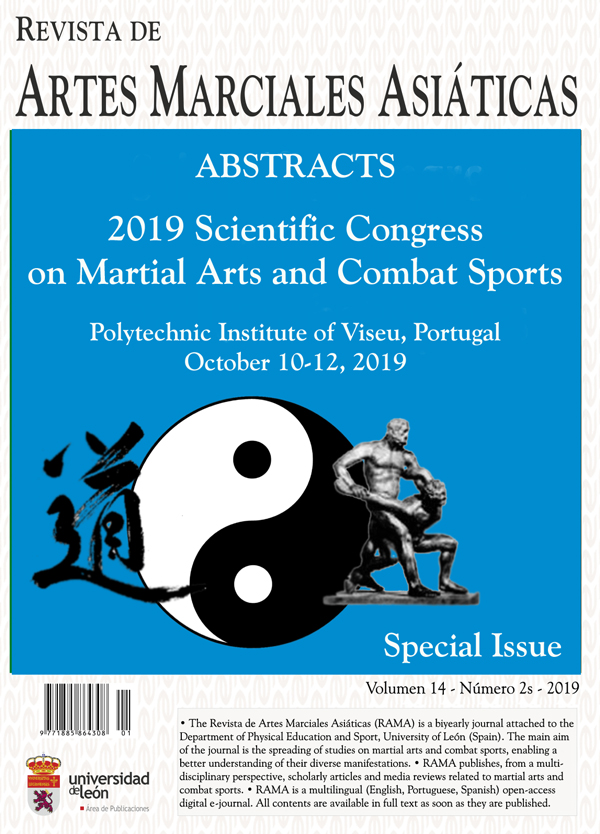The benefits of Functional Movement Screen in judo
DOI:
https://doi.org/10.18002/rama.v14i2s.5988Keywords:
Martial arts, combat sports, FMS, asymmetries, prevention, screening, testAgencies:
University of Essex, Essex Pathways DepartmentAbstract
With the development of screening methods, simple screening tools could commonly be used to assess movement quality in real-world conditions. One of those methods is the functional movement screen (FMS), that was developed to helps determine the fundamental movement patterns of an individual. FMS test was administered to 9 elite judokas aged 22 ± 4.24 years, height 176.44 ± 7.44 and weight 79.44 ± 15.92 kg. The overall FMS score was 17.56 ± 1.59. No significant asymmetries were noted in the bilateral test. The lowest score was achieved in shoulder mobility 1.89 ± 0.6 which represent and issue that needs to be addressed to prevent the occurrence of injuries. Overall the FMS testing could be a beneficial tool to strength and conditioning coaches in judo, especially in the preseason to assess the functional movement status of judo athletes and to address any issues that could be identified. It represents a fast and affordable screening tool, but it needs to be administered by a qualified assessor. The data of this study could serve as a reference score to other FMS research in judo or other combat sports or martial arts.
Downloads
Métricas alternativas
References
Boguszewski, D., Buda, M., Adamczyk, J. G., & Białoszewski, D. (2017). Relationship between functional limitations of the locomotor system and performance in judo. Polish Journal of Sport and Tourism, 24(3), 145–149. doi: https://doi.org/10.1515/pjst-2017-0015
Ciz, I., Štefanovský, M., Matejová, L., & Lopata, P. (2017). Functional movement screening of elite judokas. In M. Chren, K. Péliová, & E. Sulovská (Eds.), Nové vedecké poznatky v gymnastike, tancoch, úpoloch, fitnes a silových športoch (pp. 13–19). Bratislava.
Cook, G., Burton, L., Hoogenboom, B. J., & Voight, M. (2014a). Functional movement screening: the use of fundamental movements as an assessment of function - Part 1. International Journal of Sports Physical Therapy, 9(3), 396–409.
Cook, G., Burton, L., Hoogenboom, B. J., & Voight, M. (2014b). Functional Movement Screening: The Use of Fundamental Movements as an Assssment of Function - Part 2. International Journal of Sports Physical Therapy, 9(4), 549–563.
Jerman, P., Dolenc, M., & Šimenko, J. (2017). Movement efficiency of recreational judokas. Šport: Revija Za Teoreticna in Prakticna Vprasanja Sporta, 65(1/2), 120–123.
Kraus, K., Schütz, E., Taylor, W. R., & Doyscher, R. (2014). Efficacy of the Functional Movement Screen. Journal of Strength and Conditioning Research, 28(12), 3571–3584. doi: https://doi.org/10.1519/JSC.0000000000000556
Lockie, R. G., Schultz, A. B., Jordan, C. A., Callaghan, S. J., Jeffriess, M. D., & Luczo, T. M. (2015). Can Selected Functional Movement Screen Assessments Be Used to Identify Movement Deficiencies That Could Affect Multidirectional Speed and Jump Performance? Journal of Strength and Conditioning Research, 29(1), 195–205. doi: https://doi.org/10.1519/JSC.0000000000000613
Okada, T., Huxel, K. C., & Nesser, T. W. (2011). Relationship Between Core Stability, Functional Movement, and Performance. Journal of Strength and Conditioning Research, 25(1), 252–261. doi: https://doi.org/10.1519/JSC.0b013e3181b22b3e
Pocecco, E., Ruedl, G., Stankovic, N., Sterkowicz, S., Del Vecchio, F. B., Gutiérrez-García, C., … Burtscher, M. (2013). Injuries in judo: a systematic literature review including suggestions for prevention. British Journal of Sports Medicine, 47(18), 1139–1143. doi: https://doi.org/10.1136/bjsports-2013-092886
Šimenko, J. (2012). Analysis of movement efficiency of judoists. Šport: Revija Za Teoreticna in Prakticna Vprasanja Sporta, 60(3), 85–89.
Downloads
Published
How to Cite
Issue
Section
License
Copyright (c) 2019 Jozef Simenko

This work is licensed under a Creative Commons Attribution-NonCommercial-ShareAlike 4.0 International License.
The authors who publish in this journal must agree to the following terms:
- The authors grant on a nonexclusive basis the exploitation rights (reproduction, distribution, public communication and transformation) of the work accepted for publication to the University of León. The authors can establish, on their own, additional agreements for the non-exclusive distribution of the version of the work published in the journal (for example, placing it in an institutional repository or publishing it in a book), always acknowledging the initial publication in this journal.
- This work is licensed under the Creative Commons Attribution-NonCommercial-ShareAlike 4.0 International License. Click to see basic information and the legal text of the license.
- The authors are allowed and encouraged to disseminate electronically pre-print or post-print versions of their work before publication, as this can give rise to productive exchanges, as well as earlier and increased citing of the works published.











